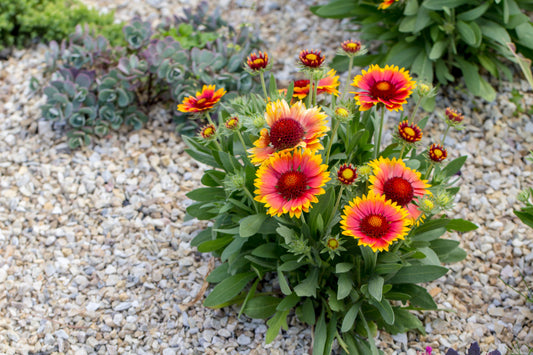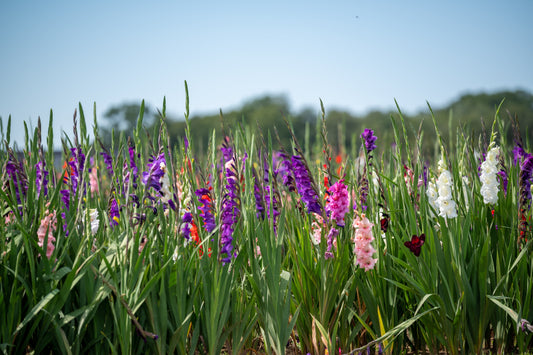Japanese Iris Planting & Growing Guide
Planting Guide Information
-
2"Planting Depth
-
18" ApartPlanting Proximity
-
SpringPlanting Season
-
Excellent performers in wet or boggy areas.Plant Benefits
-
ModerateWater Quantity
-
Spring through SummerBloom Season
-
Full to Partial SunSunlight Quantity
-
Zones 4-9Hardiness Zones
Additional Growing Information
Where to Plant
While Japanese Irises aren't particularly fussy, they fancy a spot with plenty of sunlight and averagely moist soil. In warmer regions, they will thrive in wet areas, such as on the edge of a pond. Some gardeners choose to plant their Japanese Irises in containers because this offers some flexibility for providing the moist soil these plants prefer.
When to Plant
Japanese Iris rhizomes should be planted in the fall for stunning spring blooms. However, they can be transplanted nearly anytime from spring until fall, depending on the climate, if you keep them wet and at a stable temperature. Those in warmer climates can expect foliage to form in the autumn, with winter bringing taller growth and flowers emerging in the spring. In colder regions, foliage and flowers will hold off until winter has passed and start developing in the spring.
How to Plant
- Soak the roots and rhizomes in water overnight before planting.
- For container planting, select a large vessel and fill it with good quality, humus-rich soil—almost any commercially available potting medium will work fine. If the soil is heavy or compacted, add a bit of compost. Tuck each rhizome, with the roots slightly spread out and pointing downwards, into holes 3–5" deep and about 12–16" apart. The junction point between the foliage fan and the roots should be 1" below soil level. Pat the soil firmly around the plants and apply mulch to retain moisture and prevent winter heaving.
- For outdoor landscape planting, select a spot where the soil has an average amount of moisture, and your Japanese Irises will receive full-day sun. Tuck each plant, with the roots slightly spread out and pointing downwards, into holes 3–5" deep and about 12–18" apart. The junction point between the foliage fan and the roots should be 1" below soil level. Pat the soil firmly around the plants and apply mulch to retain moisture and prevent winter heaving.
- Water generously after planting to settle the soil around the roots.
How to Grow
- Keep your plants well watered until fully established, and then water as needed during active growth periods. Roughly 1" of moisture per week is a reasonable estimate.
- Keep the foliage in place after blooming has finished for the season - don't cut it off. The leaves will gather sunlight to create food through photosynthesis and strengthen the bulbs for the future.
- Remove the foliage when cooler weather arrives and the leaves begin to turn yellow and die back.
- Allow your Japanese Irises to rest for a few months in dormancy before beginning the next growing cycle. In warm regions, the foliage may stay green year-round.
Japanese Iris Tips & Tricks
- Plant these showstoppers beside a pond, where other plants may struggle, to enjoy double the beauty in their reflection.
- Add some compost, decomposed manure, or leaf mold if your soil is lean or sandy, as Japanese Irises prefer soil with a slightly acidic pH and generous amounts of humus and nutrients.
- Give these beauties plenty of sun - they will grow in partial shade but yield more significant numbers of blooms in stronger light.
- Expect your plants to arrive with green leaf fans and all the soil washed from the roots to ensure you won't risk introducing any soil-borne diseases into your garden. Plus, the plant is lighter and cleaner to ship!
- Feel free to snip Iris flowers when in bloom for breathtaking bouquets, as doing so will not hurt your plants.
From the Family
-
 60% Off
60% OffJapanese Iris - Zen Garden Mix
5 Japanese Iris rhizomesRegular price $19.99Sale price $19.99 Regular priceUnit price per$49.9560% Off -
40% OffBOGO
Japanese Iris - Royal Robes
1 Japanese Iris rhizomeRegular price $7.77Sale price $7.77 Regular priceUnit price per$12.9540% OffBOGO -
 40% Off
40% OffJapanese Iris - Geisha Girl
1 Japanese Iris RhizomeRegular price $7.77Sale price $7.77 Regular priceUnit price per$12.9540% Off -
 40% Off
40% OffJapanese Iris - Pink Lady
1 Japanese Iris rhizomeRegular price $7.77Sale price $7.77 Regular priceUnit price per$12.9540% Off -
Japanese Iris - Dinner Plate Eileen's Dream
1 Japanese Iris divisionRegular price $10.36Sale price $10.36 Regular priceUnit price per$12.95Sold out







